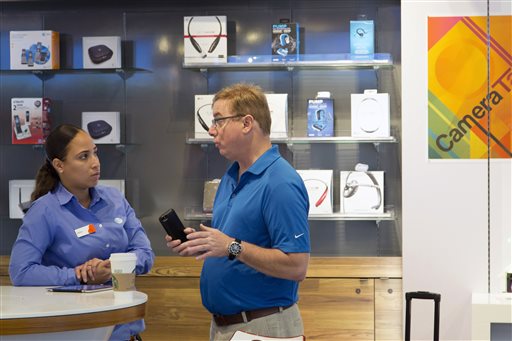Tech Tips: Your guide to the myriad phone-upgrade options

In this May 6, 2015, photo, an AT&T employee, left, works with a customer at a company store in New York. Upgrading your phone is no longer as simple as paying $100 or $200 and extending your service contract by two years. AP
NEW YORK — Upgrading your phone is no longer as simple as paying $100 or $200 and extending your service contract by two years.
Phone companies have been shifting away from contracts and trying to get you to pay full price — $600 to $700 for a high-end phone. Installment plans are available, along with a leasing option from Sprint.
To understand your options, it’s best to break down the typical monthly phone bill into three components:
— The cost of the phone, which can be the monthly installment, or zero for a traditional contract plan.
— A per-phone “access” charge for unlimited voice and texts. With contract plans, you’re paying $40 to connect a smartphone. With full-price or leasing plans, you’re paying $15 or $25. That sounds like a deal, but you’re paying more for the phone itself.
— The data bucket, typically sharable if you’re part of a group plan. This charge varies depending on how much data you need, but it’s not affected by how you buy your phone. (At T-Mobile, access and data is a combined charge.)
Are you better off with a contract plan knowing you pay less for the phone but more in service fees?
BUY IT THE TRADITIONAL WAY
Verizon, AT&T and Sprint still offer subsidies in exchange for two-year contracts. You pay $100 or $200 up front, with no additional charges for the phone itself. However, you pay $15 or $25 more each month through the access charge. That’s how phone companies make up for the cost of the subsidies.
Verizon and AT&T also charge a $40 upgrade fee when you’re getting a new phone on contract; there’s no fee when you’re paying full price for the phone. Sprint charges a $36 upgrade fee to get a new phone through the company, regardless of how you pay, while T-Mobile has no fees for its main phone plans.
PAY THROUGH INSTALLMENTS
All four national carriers let you pay the full cost of phones in monthly installments. T-Mobile no longer offers subsidies at all, so this is your best option there. Elsewhere, the installment plans go by Edge at Verizon, Next at AT&T and Easy Pay at Sprint.
For an iPhone 6 and other phones that retail for $650, the subsidy is worth $18.75 a month over the two-year life of the contract. So if the installment plan has you paying a $15 access charge, you’re saving $25 off the $40 access charge you would normally pay to get subsidies. That savings is more than what you’re giving up in subsidies, so this is a good deal for you. But if the installment plan has you paying a $25 access charge, the savings is only $15 — yet you’re giving up $18.75.
In general, you’re paying the $15 rate (and getting the bigger savings) if you’re on a higher data plan — starting at 6 gigabytes at Verizon, 8 GB at Sprint and 10 GB at AT&T. Individuals and couples probably don’t need to pay for that much data, so their rate would be $25. Again, that’s just $15 off the regular $40 access charge, or less than what you’re giving up in subsidies, so it’s not a good deal. However, installment plans typically let you upgrade phones more often, so it might still be worth paying more for that. With subsidies, you have to wait two years.
Sprint and T-Mobile charge $10 a month for the flexibility to upgrade early, before your phone is paid off. In T-Mobile’s case, the charge includes insurance for loss and damage. AT&T and Verizon include free upgrades with the installment plans, though some of its other fees are higher. In all cases, you must turn in the old phone to upgrade early.
BUY IT OUTRIGHT
Installment plans don’t charge interest, so you’re not really saving anything paying the full price up front. If you don’t have good credit, this might be your only option. This is also for those looking for a used phone from a friend or from eBay.
Another advantage: You can get an unlocked version of a phone, letting you switch carriers more easily. Be forewarned, though, that not all phones will work with all carriers. AT&T and T-Mobile phones are typically interchangeable, but Sprint and Verizon have different networking technology.
RENT IT
Sprint offers a leasing program with monthly charges that are lower than the installment plan. It’s even waiving those charges for some phones on unlimited data plans. The catch: You don’t end up owning the phone.
With other plans, you can resell the phone or give it to a friend once it’s paid off. With leasing, you turn in the old model for a new one when the lease runs out in 12, 24 or 30 months. Or you can pay the difference between the full cost of the phone and the amount you’ve already paid to lease it. If your old phone is simply going to sit in a desk drawer when you upgrade, leasing could help you save money each month.
… OR WAIT
Do you really need to upgrade now?
It might be a good time if you use Android, as new models from Samsung and HTC just came out. LG’s G4 phone is due out soon.
A new iPhone is expected in September, at which time current models will probably be cheaper. Waiting might be your best option if your iPhone is still working.